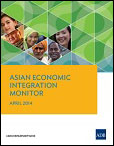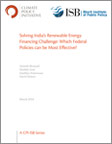Assessing the Costs of Climate Change and Adaptation in South AsiaThis book discusses the economic costs and benefits of unilateral and regional actors on climate change adaptation in Bangladesh, Bhutan, India, the Maldives, Nepal, and Sri Lanka. It provides the total economic loss throughout the 21st century and estimates the funding required for adaptation measures to avert potential losses. Huge impacts are likely on vulnerable sectors in the region, with South Asia losing on average nearly 2% of its gross domestic product by 2050. Results of the study will aid climate change adaptation in the region, including initiatives for regional cooperation. Author: Mahfuz Ahmed and Suphachol Suphachalasai Year: 2014 Download Tags: Climate, South Asia, Regional Cooperation, Energy, Bangladesh, Bhutan, India, Maldives, Nepal, Sri Lanka Simulating World Trade in the Decades Ahead: Driving Forces and Policy ImplicationsThis working paper considers economic prospects up to the year 2100, offering assumptions about key exogenous variables, providing a baseline for climate change policy evaluation, and discussing sectoral and trade issues. The paper combines an economic growth model with a multi-sectoral model to construct scenarios for around 150 countries up to a maximum time horizon of 2035, with forecasts on a number of key variables such as energy prices, demographics, etc. It suggests that trends toward increased regionalization may be reversed, with multilateral trade relationships gaining in importance. Author: Lionel Fontagné, Jean Fouré and Alexander Keck Year: 2014 Download Tags: Climate, Trade, Statistics, Trade Policy, Policy, Energy, Tariff, ASEAN, India, Environment  Asian Economic Integration Monitor - April 2014The Asian Economic Integration Monitor, a semiannual review of regional economic cooperation and integration in Asia covers regional economic updates, intraregional trade, financial integration and investment, and the importance of disaster risk financing instruments. The Theme Chapter: Insuring Against Asia’s Natural Catastrophes discusses market solutions and the role of government in developing disaster risk financing and strengthening financial resilience. The economic update section encourages strengthening regional cooperation in surveillance and financial safety nets, and deepening economic links. Inter-subregional trade between each subregion and the rest of Asia is rising, except in South Asia, while financial integration continues to deepen across the region. Author: Asian Development Bank Year: 2014 Download Tags: Regional Cooperation, Regional Integration, South Asia, Disaster Risk, Climate, Bangladesh, Bhutan, India, Maldives, Nepal, Sri Lanka, Transport  Solving India’s Renewable Energy Financing Challenge: Which Federal Policies can be Most Effective?As India works toward increasing the use of renewable energy across the country, unsubsidized renewable energy remains 52-129% more expensive than conventional energy and needs policy support. This joint publication by the Climate Policy Initiative and Indian School of Business weighs in on federal policies that can provide a solution to India's renewable energy challenge, and asks whether existing support policies are the most cost effective.
Various policies are assessed, in light of the different criteria federal policymakers consider. Existing federal policies are compared with a recommended class of debt-related federal policies using a suggested framework. The study concludes that long-term, debt-related policies are more cost-effective. The research also presents viable short-term policy options. Author: Gireesh Shrimali, Shobhit Goel, Sandhya Srinivasan, David Nelson Year: 2014 Download Tags: Energy, Climate, India Who Shapes Climate Action in India? Insights from the Wind and Solar Energy SectorsThis report discusses climate change as a problem with domestic and international dimensions that intersect in complex ways. It focuses on the main players - including government, private sector, and civil society - by attempting to understand their influence in shaping climate change within India. Wind and solar sectors are highlighted as renewable energy is an important part of the energy mix and there has been remarkable activity in these sectors in recent years. The case studies describe key discourse and perceptions influencing renewable energy policy and the central questions shaping climate policy in India. Author: Ankur Chaudhary, Ankita Narain, Chetan Krishna and Ambuj Sagar Year: 2014 Download Tags: Climate, Energy, India Financing Low-Carbon UrbanDevelopment in South Asia: A Post-2012 Context The cities of South Asia are growing at an unprecedented rate. Currently, the region
accounts for 5 of the world's 26 megacities (Delhi, Dhaka, Karachi, Kolkata, and
Mumbai),with Kolkata and Mumbai being the most dense. The urban population in
India is expected to increase by 20.8 percentage points between 2010 and 2050 compared
to 7.8 percentage points in Latin America and the Caribbean. These trends necessitate bold
efforts in project design and financing to steer this rapid urbanization onto an inclusive, green,
and low-carbon urban development path. Author: Asian Development Bank Year: 2013 Download Tags: Climate, Energy, India, South Asia, Kyoto Protocol, Bangladesh, Bhutan, Nepal, India, Maldives, Sri Lanka Climate Action South Asia: Information Update No. 3 (The Economics of Climate Change in South Asia: Adaptation and Impact Assessment)Analyses show that the cost of early action on climate change in South Asia is lower than
the cost of damage brought about by climate change impacts. In physical terms, the region
will face water shortage and agricultural food production losses, which are vital to achieving
poverty reduction and other Millennium Development Goals (MDGs). Author: Asian Development Bank Year: 2013 Download Tags: Economics, Climate, Agriculture, Climate Change, Environment, South Asia, Milennium Development Goals, Sustainability, Bangladesh, Bhutan, India, Nepal, Maldives, Poverty Reduction, Hydropower, Energy Climate Action South Asia: Information Update No. 2 (Economics of Reducing Greenhouse Gas Emissions in South Asia: Options and Costs)The study Economics of Reducing Greenhouse Gas Emissions: Options and Costs in Bangladesh, Bhutan, the Maldives, Nepal, and Sri Lanka reveals excellent opportunities in low-carbon green growth by pursuing resource- and energyefficient technologies that would lower emissions of greenhouse gases at low cost or even cost saving (benefits). Author: Asian Development Bank Year: 2013 Download Tags: Economics, Climate, Climate Change, Economics, South Asia, Bangladesh, Bhutan, Maldives, Sri Lanka, Energy, Environment, Sustainability, ADB, Nepal, Development, Hydropower Climate Action South Asia: Information Update No. 1 (Development in an Era of Accentuated Climate Risks)To steer South Asian economies toward green, low-carbon, and climate-resilient development and for these to take hold in South Asia, the countries need (i) better understanding and greater public awareness of the implications of climate change, (ii) climate risks screening and decision-support tools for identifying actions and managing results, (iii) improved governance and institutional capacities to take necessary actions to manage climate change impacts, (iv) funding sources for such actions, and (v) projects and programs demonstrating positive results that can be scaled up. Author: Asian Development Bank Year: 2012 Download Tags: Economics, Climate, Climate Change, Environment, Sustainability, South Asia, Development, Economic Growth, ADB |




